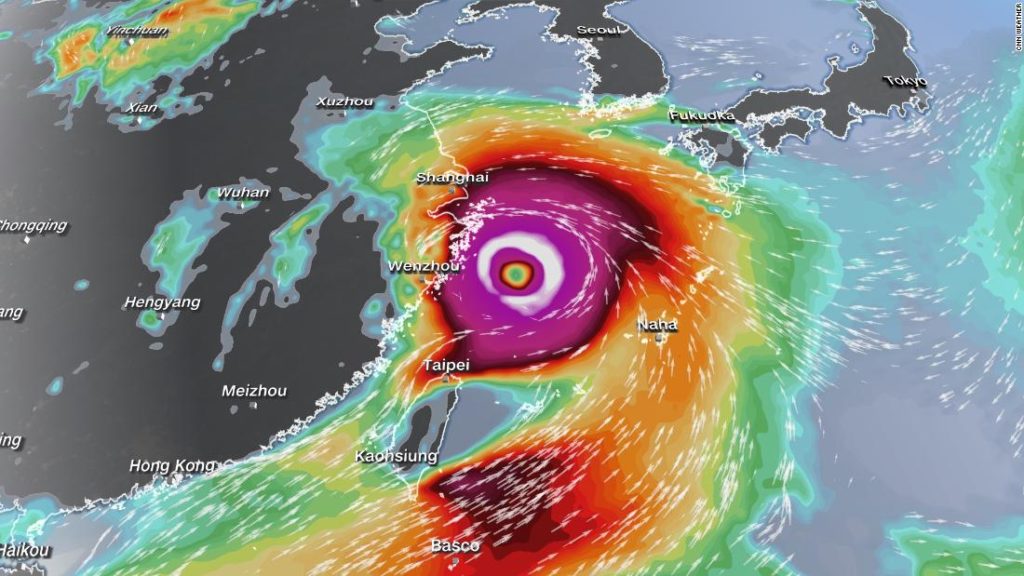In-fa is currently located about 275 kilometers (170 miles) west-southwest from Okinawa and is moving northwest. The storm has been a typhoon for much of this week but has now weakened to a strong tropical storm, with winds up to 110 kph (70 mph) near its center, as of the 5 p.m. ET update from the Joint Typhoon Warning Center.
In-fa has been weakening due to dry air, thus weakening its thunderstorms, as well as slightly cooler sea surface temperatures.
The good news is no significant strengthening of this storm is expected because of this. But it will still be a strong tropical storm or weak hurricane impacting land in the northwest Pacific Ocean.
In-fa will head toward eastern China
In-fa is beginning to pull away to the north and west from the Japanese islands, but rain and wind will persist into Saturday.
The center of the storm is now passing well north of Taiwan, but the island will still receive major amounts of rain.
“The mountain chain in Taiwan could squeeze up to a meter’s worth of rain over the region, while Taiwan has been dealing with its worst drought in some 50 years. This amount of rain could lead to catastrophic flash flooding and landslides,” says CNN meteorologist Tom Sater.
An additional 50 to 150 millimeters (2 to 4 inches) is expected through Saturday night.
As In-fa pulls away from Japan and Taiwan this weekend, the storm will head toward eastern China and will likely affect the area beginning Sunday.
It is expected to make landfall in the area between Shanghai and Wenzhou, bringing strong winds and heavy rain.
The typhoon warning center is expecting maximum sustained winds near the center of the storm to be at about 60 mph (95 kph), which is a strong tropical storm. However, the storm may still be at typhoon intensity due to some uncertainty still in the forecast.
The greater concern is for flooding rains possible for highly populated areas of China.
“Heavy rain will be the story with this as much of it on the Shanghai side of the storm and where most of the moisture is pushed onto shore,” says CNN meteorologist Michael Guy.
“Rainfall up to 10 inches (250 millimeters) will be widespread with higher amounts up to 20+ inches (500+ millimeters) in isolated locations. Flooding will be a major concern from this.”
Nepartak may affect the Olympics
On the heels of Tropical Storm In-fa is Tropical Storm Nepartak, a new subtropical cyclone that formed Friday night over the western Pacific Ocean.
It formed about 1,300 kilometers (800 miles) southeast of Japan, and currently has maximum sustained winds of 65 kph (40 mph) as of the 5 p.m. ET update, according to the typhoon warning center.
The forecast track from the center brings the storm to mainland Japan by Tuesday, with Tokyo in the forecast cone.
Nepartak is classified as a subtropical cyclone and is expected to remain subtropical through its forecast period. This characteristic essentially means the strongest winds won’t be just consolidated near the center of the storm, but rather can extend farther out from the center.
The storm is expected to strengthen over the coming days, reaching tropical storm intensity this weekend.
By Sunday night, its winds are expected to peak at 85 kph (55 mph) before gradually weakening again.
Nepartak is expected to affect parts of mainland Japan by Tuesday, including the Tokyo area where the Olympics are taking place. Maximum winds are expected to be around 65 kph (40 mph) when it reaches Japan.
There remains a high amount of uncertainty with the forecast by early next week, the center notes in its discussion, in terms of where it affects Japan and the strength of its winds.
You may also like
-
Afghanistan: Civilian casualties hit record high amid US withdrawal, UN says
-
How Taiwan is trying to defend against a cyber ‘World War III’
-
Pandemic travel news this week: Quarantine escapes and airplane disguises
-
Why would anyone trust Brexit Britain again?
-
Black fungus: A second crisis is killing survivors of India’s worst Covid wave

